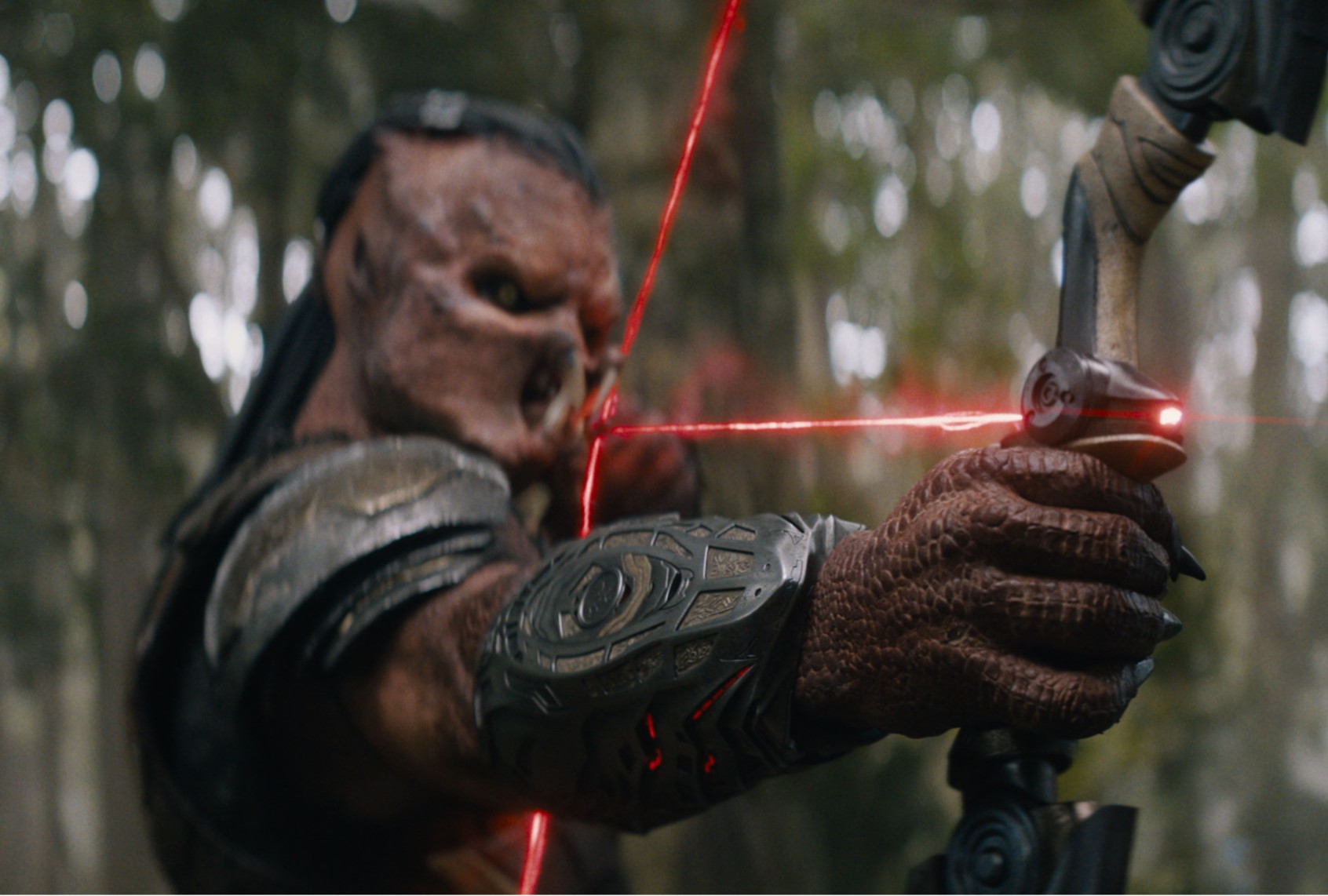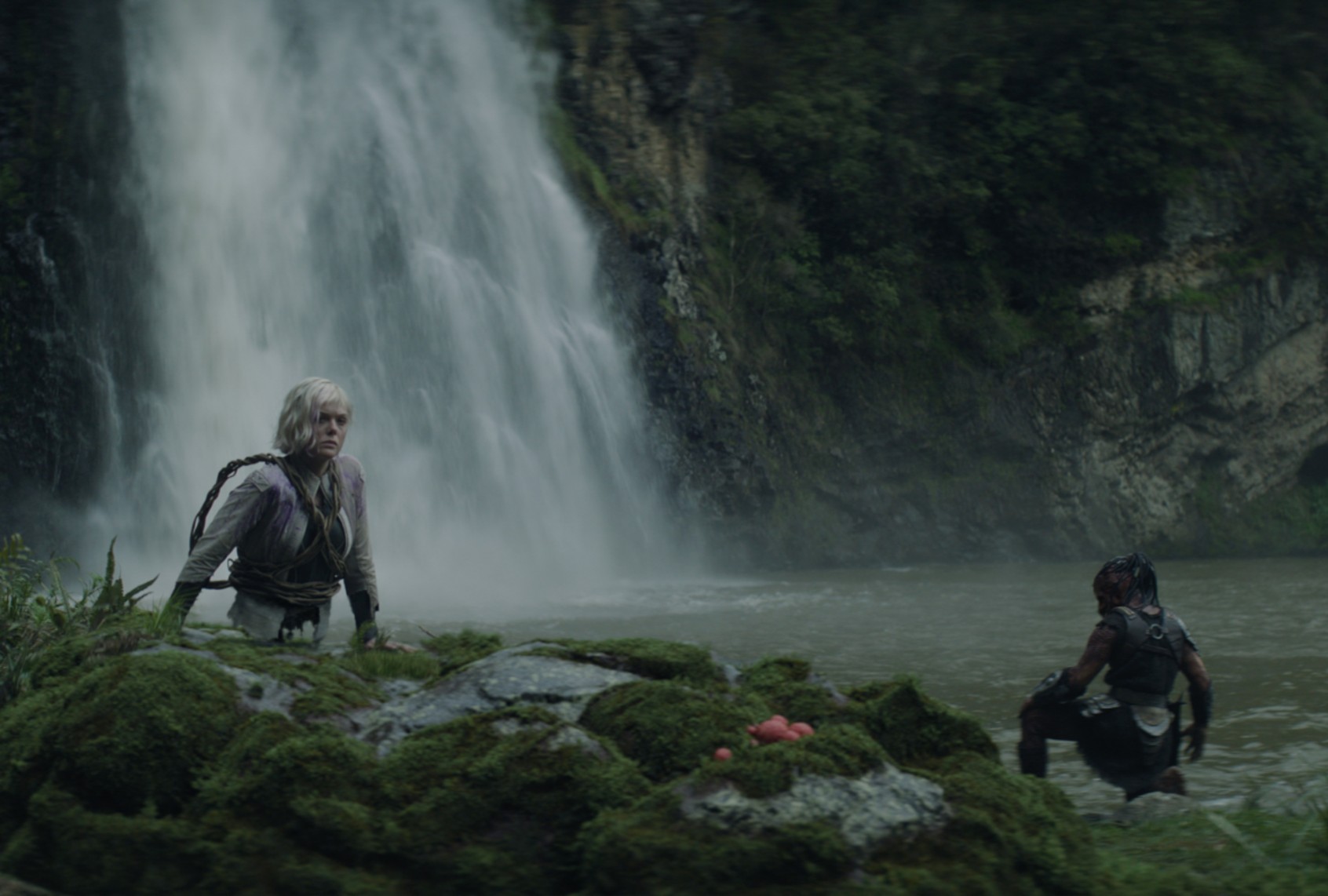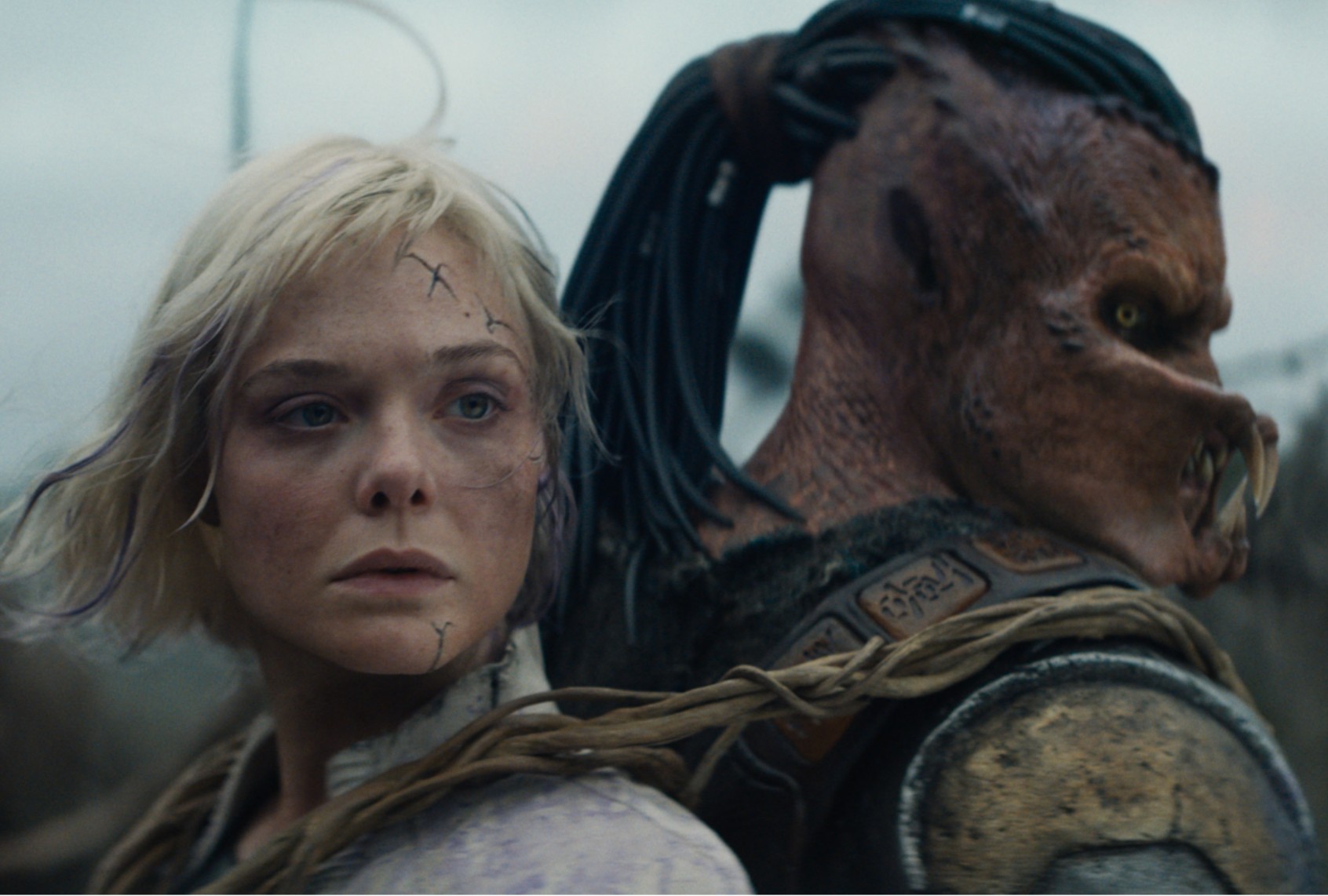In placing his spin on the “Predator” universe, director Dan Trachtenberg has ushered in several crucial firsts. His 2022 debut, “Prey,” is the first major movie to feature a Native American woman, Amber Midthunder, as the lead in a film released with a Native American language overdub.
Trachtenberg’s “secret” follow-up that landed earlier this year, the animated “Predator: Killer of Killers,” is the first to provide a glimpse of the lethal alien race’s home world, Yautja Prime.
Now, nearly four decades after Arnold Schwarzenegger’s commando Dutch Schaefer survived his encounter with a Yautja – long before anyone knew that’s what they were called – “Predator: Badlands” makes one of them the hero.
In this extraterrestrial warrior culture, one’s worthiness is defined by one’s ability to hunt and kill other lifeforms with honor, which makes Dek (Dimitrius Schuster-Koloamatangi) an outsider in several respects.
As an “un-blooded” member of his clan (the term for those that have yet to engage in their first hunt), Dek doesn’t have the right to call himself Yautja. That, he can remedy, as his brother Kwei (Mike Homik) trains him to do. But Dek is the approximate size of a large human, a veritable runt in a race of beings that are typically between 7 and 8 feet tall. His diminutive stature is unacceptable to his father, Njohrr (Reuben De Jong), who views him as fit only for culling.

(20th Century Studios) Dimitrius Schuster-Koloamatangi as Dek in “Predator: Badlands”
In this extraterrestrial warrior culture, one’s worthiness is defined by one’s ability to hunt and kill other lifeforms with honor, which makes Dek (Dimitrius Schuster-Koloamatangi) an outsider in several respects.
To earn his “cloak,” a symbol of acceptance as a full-fledged member of his clan, Dek travels to the planet Genna to bag a Kalisk, a fellow apex predator even his father won’t risk his life against. Before he can confront that beast, he must survive the land itself.
Everything in Genna’s ecosystem treats Dek as potential food, testing his skills and his species’ arrogant assumption of their physical and technological superiority. The grass is razor sharp. Worms explode. Even the trees have carnivorous tentacles. Once he figures out a way to navigate its deadly forests and fields, there’s a deadlier obstacle between him and his quarry: a bioweapons retrieval team deployed by the Weyland-Yutani Corporation.
“Predator: Badlands” is the best-executed “Alien” crossover yet because it isn’t overtly an “Alien vs. Predator” entry, or even a by-the-numbers “Predator” sequel. Certainly, that branding combo, along with its PG-13 rating, helped it score a $40 million opening weekend domestically. That number balloons to $80 million once the worldwide box office tally is taken into account, giving it the biggest debut in the franchise’s history. But I suspect that what drew people to theaters who would otherwise wait for the streaming window is Trachtenberg’s demonstrated understanding that these are power fantasies for underdogs, whose plots both align with the universe’s testosterone-pumped origins and steer it in welcome new directions.
The highest profile “Predator” movies feature A-listers at the peak of their powers when their installment came out; Adrien Brody had an Oscar to his name when he toplined 2010’s middling “Predators.” Really, though, it’s the aliens we root for. Physically imposing and extensively equipped with futuristic gadgets, they recategorize humanity from the supposed “most dangerous game” to overly confident meat.

(20th Century Studios) Elle Fanning as Thia and Dimitrius Schuster-Koloamatangi as Dek in “Predator: Badlands”
“Predator” is prime Reagan-era action propaganda, closely associating male potency with guns and their firepower, daring to counter that gospel by reminding its audience of how soft humans are once the ammo runs out. Even the burly Apollo Creed himself, Carl Weathers, doesn’t go down without losing his entire arm in a single laser slice.
The 1987 movie features Schwarzenegger’s Dutch leading a multiracial band of bros on a black ops mission to eliminate guerrillas in a Central American jungle, only to be butchered by an invisible stalker from space. “Predator 2” pits Los Angeles cops, headed by Danny Glover‘s Lieutenant Mike Harrigan, against its extraterrestrial threat — another state-sanctioned group of agents empowered to use deadly force against invaders. That includes the department’s original targets, Jamaican and Colombian drug cartels.
Trachtenberg trades those earlier narratives for populist paladins drawing on their will and ingenuity in the face of overwhelming odds. His last men and women standing battle colonizers, homicidal usurpers, coldhearted patriarchs and Nazis before they face one of these intergalactic killers. Perhaps the great irony of the Yautja is their egalitarian view of the lifeforms they hunt, one of several ways they’re more honorable than humans. (They also consider slaughtering children, the sick and the elderly to be cowardly.) Therefore, fortune does not favor the brawny, or people armed to the teeth, or one sex over another. Success always comes down to superior cunning.
We need your help to stay independent
Regardless, the human vanquishers are not champions. At best, they’re survivors. Hence, the movies’ appeal to nerds of all stripes — especially queer fans, who recognized the 1987 movie’s strong current of homoeroticism long before everyone else drawn to those oiled biceps and machine guns figured out that “Predator” director John McTiernan meant his heroes’ swagger to land as parody.
The “Predator” franchise is only slightly younger than “Star Wars” but equally as canny when it comes to marketing to children. The original may have been R-rated and extraordinarily violent, but it also has its own action figure line. And yet, as author and “Predator” superfan Ander Monson writes in his 2022 book “Predator: A Memoir, A Movie, An Obsession,” “‘Predator’ is a tool through which America sees itself, or has the opportunity to see itself if it’s paying attention.” What it reflects now is worth close consideration.
Fortune does not favor the brawny, or people armed to the teeth, or one sex over another. Success always comes down to superior cunning.
The Yautja are a ruthless culture whose warriors take pride in hunting alone, and Dek’s stubborn adherence to those rules, even as an outcast, is nearly his undoing. Only when he nearly dies does Dek grudgingly welcome assistance from Thia (Elle Fanning), a Weyland-Yutani synthetic he encounters while being hunted by a winged fright. When they meet, Thia only has an upper body, but her supercomputer of a brain guides Dek to safety and through an assortment of other natural dangers. For that reason, he decides she’s useful and totes her around like a backpack.
Thia is also programmed to have feelings, primarily empathy, to better understand the flora and fauna she’s stranded amidst. Weyland-Yutani’s primary mainframe, MU/TH/UR, has mercenary reasons for that choice, but for the bulk of “Badlands” and even after that twist is revealed, Thia persuades Dek that empathy can be as useful in his arsenal as she is, especially in seeing the value of a small being they pick up along the way that she calls Bud. Inserting any creature that could be thought of as cuddly into a universe whose antagonists have a yen for ripping the skulls and spines from their victims is, at best, a test of customer loyalty. It’s also a friendly reminder that this adventure is being brought to us by Disney.

(20th Century Studios) Elle Fanning as Tessa and Thia in “Predator: Badlands”
But that criticism does little to weaken the subtextual conversation the movie is having with dominant and flawed definitions of masculinity right now, especially versions that declare empathy to be toxic and cast diversity as a weakness. Dek’s father Njohrr adheres to that same gospel so zealously that he’s willing to murder his child.
Synths aren’t supposed to have a conscience, but they also lack fear as we know it, which is to say the variety that breeds ignorance. That lends a compelling shade to Fanning’s dual role and starkly different presentations of Thia and Tessa. Thia views Genna and her new traveling companions as wonders. Tessa sees it as a mission, one of dozens that involve the company colonizing planets and stripping their resources, justifying that plunder as necessary to benefit mankind. Tessa is the hard steel trap to Thia’s openness, the synth devoted following her superior’s orders regardless of how cruel they might be. To her, Thia’s empathy is a defect.
Want more from culture than just the latest trend? The Swell highlights art made to last.
Sign up here
This is also as fine a time as any to acknowledge that our interpretation of diversity in this film’s context has little resemblance to how it’s defined in American culture. Pretty much every other “Predator” movie is visibly diverse, while there are just two non-white people with a major onscreen role in “Badlands”: its Samoan-Tongan star, Schuster-Koloamatangi, and Rohinal Narayan, who plays Bud. Moreover, Schuster-Koloamatangi’s face is entirely obscured by movie’s excellent digital animation.
Then again, the cast isn’t very big. Besides Fanning’s, the only other mug copied on the dozens of Weyland-Yutani androids working under Tessa is that of fellow actor Cameron Brown. There are no human characters in “Badlands,” only expendable mechanical representatives of a megacorporation bent on bringing the known universe to heel. Look at photos of Weyland-Yutani’s contemporary corporate equivalents. What do those calculating people look like?
Criticism does little to weaken the subtextual conversation the movie is having with dominant and flawed definitions of masculinity right now, especially versions that declare empathy to be toxic and cast diversity as weakness.
Meanwhile, the heroes in “Predator” can look like anyone. “Prey” gave us an 18th-century Comanche woman, Naru, who beat her tribe’s hunter from beyond the stars with the same ingenuity that Dutch employed. The climactic battle in “Killer of Killers” involves a Viking warrior mother, a 17th-century shinobi, and a Hispanic World War II-era pilot working together, despite vast cultural differences and language barriers, to survive a Yautja death match.
“Badlands” is one of many “Predator” stories in a canon that spans films, comic books and novels featuring a Yautja partnering with another being as a means of survival at first, eventually coming to respect and prize their complementary strengths.
Dek and Thia are underestimated and perceived as unworthy of equal treatment, while Bud is a foundling seemingly left to fend for herself. Combining their strengths enables them to best everything that a world that wants to consume them sets in their path. They emerge from Genna not merely as survivors, but victors. There’s an emboldening lesson in that if you choose to take it in.
Otherwise, there’s a end-credits scene setting up a sequel. Maybe by the time it comes out, life will feel less like navigating a hunting ground.
“Predator: Badlands” is playing in theaters worldwide. “Prey” and “Predator: Killer of Killers” are streaming on Hulu.

